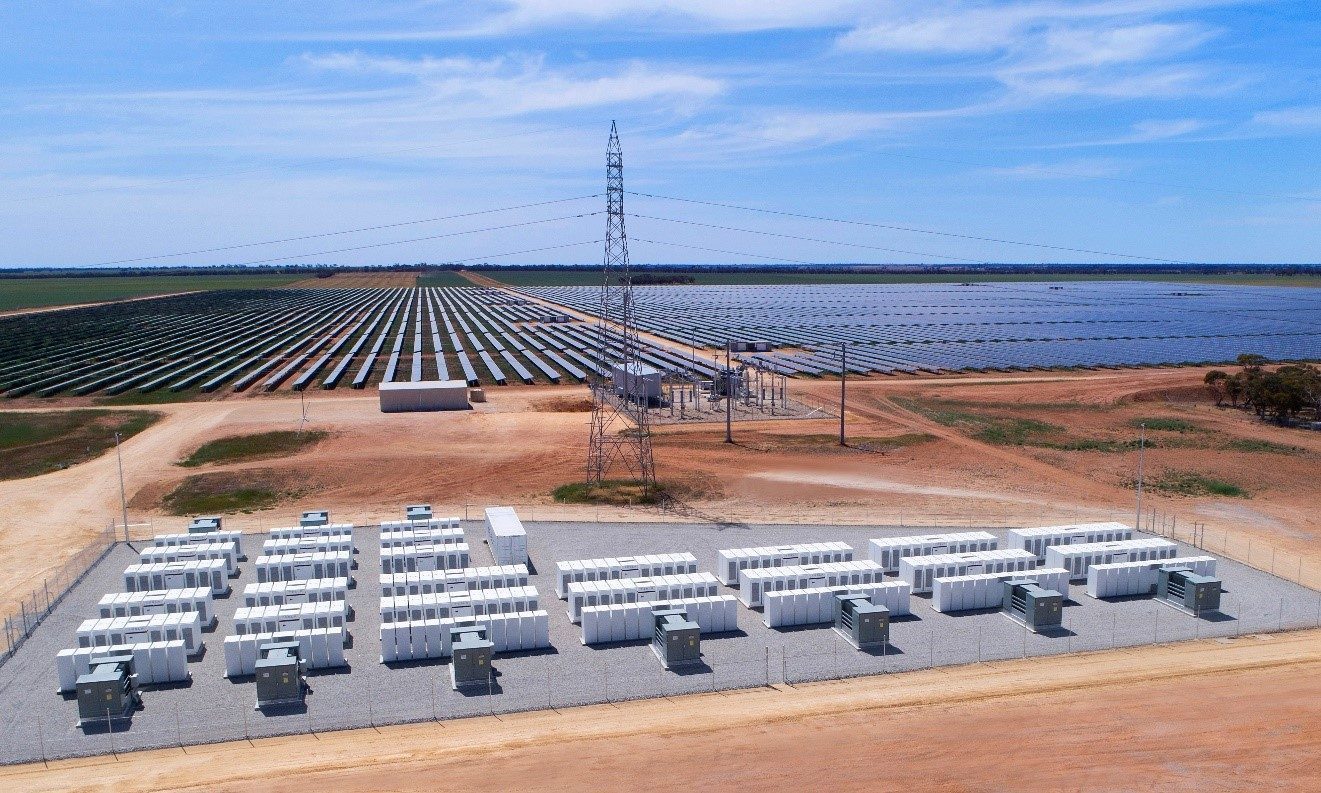Elgar Middleton has extensive debt and equity experience in arranging finance for BESS portfolios, having closed three market-leading transactions in the UK in the past 18 months totalling more than £600m. Our experience covers bankable revenue structures (such as merchant vs fixed / floored optimisation arrangements) and bankable technical arrangements including around BESS duration, warranty length, cycling limits, and degradation curves.

The Climate and Net Zero….
The lowest hanging fruit of the energy transition has long been recognised to be the decarbonisation of the electricity sector, which has been satisfied by a large increase over the past c.20 years of intermittent generation capacity, predominantly wind and solar.
The ever-increasing intermittent generation supply and a move away from large steady state carbon generating power stations create a more volatile energy market, with increased imbalance potential arising from sudden changes in the weather. Unforeseen low wind and low temperatures in the winter can lead to soaring intraday wholesale market (WM) and balancing mechanism (BM) prices when demand massively outstrips supply, or alternatively the prices can swing downward when there are unexpectedly milder conditions and/or strong winds – even giving rise to significant periods of negative pricing due to the surplus of supply versus demand. All of this leads to increased volatility and wider pricing spreads for each MWh bought or sold. The sudden and unpredictable supply / demand imbalance suits BESS which can deploy during periods of high demand at peak prices or receive a premium when there is high supply and negative prices. Over the past 3 years this had led to a huge increase in the deployment of BESS in the UK from under 1GW online at the end of 2020 to 4GW by the end of 2023.
Capacity Market and Ancillary Services
WM and BM revenues are examples of energy trading revenues: participation in a market that (in theory) balances supply and demand in each period to give the best deal for consumers. The supply of electricity needs to be reliable as well as cheap, giving rise to further opportunities for BESS assets that less sophisticated zero-marginal cost generators (such as wind or solar) might bypass. For instance, the UK seeks to manage a degree of safety margin by awarding Capacity Market (CM) contracts through the National Grid’s Electricity Transmission System. These contracts are awarded on either a one- or fifteen-year basis and provide stable revenues for BESS.
Not only are BESS well suited to responding rapidly to supply and demand imbalances through energy trading but they can also help manage the stability of the grid through frequency response contracts, which in the UK, fall under the umbrella of ancillary services. The current suite of products includes Dynamic Containment (DC), Dynamic Moderation (DM) and Dynamic Regulation (DR). Together these services provide system control services to maintain the grid within 50 Hz +/- 1%, and some (particularly DC) are well suited to BESS given its ability to respond very quickly (sub 1 second) to ensure small deviations from the target frequency do not develop into larger issues. NGESO is responsible for the award and management of these services.
There are some subtleties around the awarding of these contracts, including the time period for which these contracts are held and when they are contracted relative to the delivery of the service, but one important point is that these are in general remunerated on a £/MW basis – unlike energy trading revenues which are remunerated on a £/MWh basis. So (again in general – the experience of specific assets in specific market conditions may vary) shorter-duration or degraded older assets (i.e., assets with lower MWh-to-MW ratios) might expect to see a greater share of their revenues coming from ancillary services rather than the WM or BM.
Dynamic Stacking

There are only limited restrictions for qualifying BESS assets on bidding for CM contracts or ancillary service contracts as well as bidding into the WM and BM in any given half-hour period. This freedom allows BESS participants to stack revenues across multiple revenue streams in the same trading periods. This flexibility increases BESS efficiency in delivering services, increases competition and in turn should reduce costs to the consumer.
In addition to the various stacked revenues relating to delivery of ancillary services or energy trading activity there is also scope for ‘churn’ as the icing on the cake. This is simply unwinding a physical contract to deliver in future (say, in the day-ahead wholesale market) prior to physical delivery (say, by taking an offsetting position in the intraday or balancing markets) for a profit. This is valuable because it allows the asset to respond to rapidly evolving market conditions at almost no marginal cost (including avoiding degradation from the charging and discharging of the asset that is necessary for physical delivery). 12-18 months ago, this revenue stream would have been seen as some sort of esoteric equity upside but is now accepted as a normal part of BESS operations and forms part of a bankable business case.
Optimised and Arbitrage Trading
There is usually a separation between asset owners and asset operators, as there are very different barriers to entry in owning a BESS asset compared to trading power in the regulated electricity markets. As the various revenue streams and asset classes are better understood there have been a number of trading counterparties establish themselves in the marketplace: some of these are inhouse teams of the big utility companies while others are bespoke nimble trading platforms which have joint ventured with a larger corporate to provide bankable products. The range of products has evolved such that ten-to-fifteen-year Optimisation Agreements (OA) now exist with offerings for both fixed price and a floor plus an incentive pass through arrangement to align the interests of an asset owner or financier and an optimisation trading counterparty. Optimisers operate within technical parameters set from time-to-time by asset owners. While a CM contract and OA floor cannot fully protect senior debt it does underwrite a significant degree of market protection, although senior debt providers still need to assume some market risk to participate in the BESS sector.
There is no doubt as the trading platform optimisers evolve there is almost certainly going to be some divergence in performance as those with the most agile platforms will adapt to maximise arbitrage revenues between the physical and virtual markets across both the WM and BM. Many contracts that we see used for debt-financed transactions recognise this optimiser performance risk by ensuring that asset owners have the right to replace the counterparty where performance is poorer than had been advertised.
Duration, Warranty, Cycling, and Degradation
BESS assets are more technically complex than many of the assets that come across the average UK project finance lender’s desk. This nascent market is rapidly adapting to several somewhat unpredictable factors and its impact on both senior debt cover ratios and equity IRRs. The four key technical parameters of duration, warranty, cycling and degradation impact both the project economics and the risk profiles for lenders and asset owners.
BESS duration first began commissioning at one hour in the UK market, but two hours is now the norm. This reflects that historically the ‘buy low, sell high’ approach that underpins arbitrage business models has become increasingly viable as costs have fallen and wholesale market volatility has increased. This trend now means that some of the newest systems now benefit from four-hour duration to offer even greater trading flexibility. Higher storage duration has a non-linear impact on both capital expenditure and revenues so careful analysis is required to ensure it can be properly evaluated from an equity IRR perspective.
Similarly, warranty duration, correlated to senior debt gearing, needs to be considered over various time periods to find the optimum solution between equity IRR and senior debt gearing. Our experience is that the warranty period is often the constraint for prospective BESS lenders and hence paying for an additional warranty at the back end of the expected asset life can ‘pay for itself’ through increased debt capacity – although again this will depend on the cost of the product and the broader warranty package on offer, where there is as yet limited convergence on a market standard offering.
The cycling strategy is a function of the local market dynamics and the optimiser’s deployment plans and there are various conflicting viable solutions in the UK, typically between one and two full cycles per day. Again there are equity and senior debt considerations, as a higher cycling strategy may quite possibly suit both equity and senior debt, given increased revenues, but this comes at a cost (increased degradation) which is non-linear and potentially conflicts with either the cell manufacturer’s warranty package or, for less extreme increases in cycling, with the lenders’ base case – meaning that the cashflow projections late in the asset life become less reliable. These conflicts are often resolved by limiting annual cycling which needs to be included in the equity return calculations. Another option, popular with lenders but not always with sponsors and not always required, is some kind of upside-sharing approach that de-risks lenders. The principle is that if outperformance comes about from higher cycling than base case, then this should pay down debt at the back end of the project where the cashflow forecasts are now less reliable.
Evolution of the Senior Debt Market
When Elgar Middleton first began seeking senior debt for BESS in 2018 there were at most two debt funds willing to consider financing the new asset class. Having now closed three quite different structures there are over twenty senior lenders in addition to a range of debt funds able to finance UK BESS. The approach of different lenders to sizing fixed vs variable revenues, views on floors vs fixed revenue, and debt maturity have hugely different outcomes for sponsors. Unlike solar and onshore wind, one size does not fit all; some lenders will size over twenty years (and factor in a full cell replacement programme), and others don’t require any fixes or floors. More broadly, different lenders make different assessments of both the type of revenues that they class as contracted (most classify ancillary services as merchant, but some classify these as contracted or somewhere in-between the two) and the level of contracted revenue that they require to lend over different time horizons. All of this offers maximum flexibility for a sponsor depending on its key drivers with lots of possibilities to contemplate.
Co-location of solar and BESS

Having financed a mega £500m solar and BESS pipeline in the UK there is huge debt appetite for this combination. Solar and BESS complement one another well, when solar is dispatching there is limited expectation that BESS will be dispatching and so the grid can be shared. This gives a material saving on both time (given the current state of the grid connection queue) and cost with minimal impact on revenue.
The benefit of solar provides a high degree of revenue certainty, which is key for lenders who require a certain level of contracted revenue across the assets taken together; a solar asset with a fixed price PPA with an investment-grade counterparty (or, for newer assets, a UK government-backed CfD) may be largely or wholly contracted, allowing a more merchant approach to be adopted on the BESS. There is also additional downside protection when looking at the assets together, partly from diversification of revenue streams and partly from lenders taking comfort from excess solar cashflows at the end of the asset life being used to support lending against the BESS.
Taken together, this enables a co-located scheme to achieve higher gearing and take a more aggressive optimisation strategy to further enhance equity IRRs while also providing lenders with strong cover ratios. This results in material interest rate margin savings for a co-located scheme versus standalone BESS. We see this effect irrespective of the technical or contractual arrangements for the solar and BESS and so is worth pursuing even on physically separate portfolios of assets (where the cost savings are less material, but the financing benefits are still there).
Bringing it all together
Elgar Middleton has extensive knowledge of, and experience in financing, co-located BESS, standalone BESS, BESS duration, warranty duration, cycling, degradation, floors, fixes as well as the various stacked revenue streams and the interaction between all these factors. For each transaction we will work with the sponsor to develop a bespoke financing strategy and analysis to evaluate a customised physical system and the revenue profile to optimise the structuring of equity IRR and senior debt gearing.